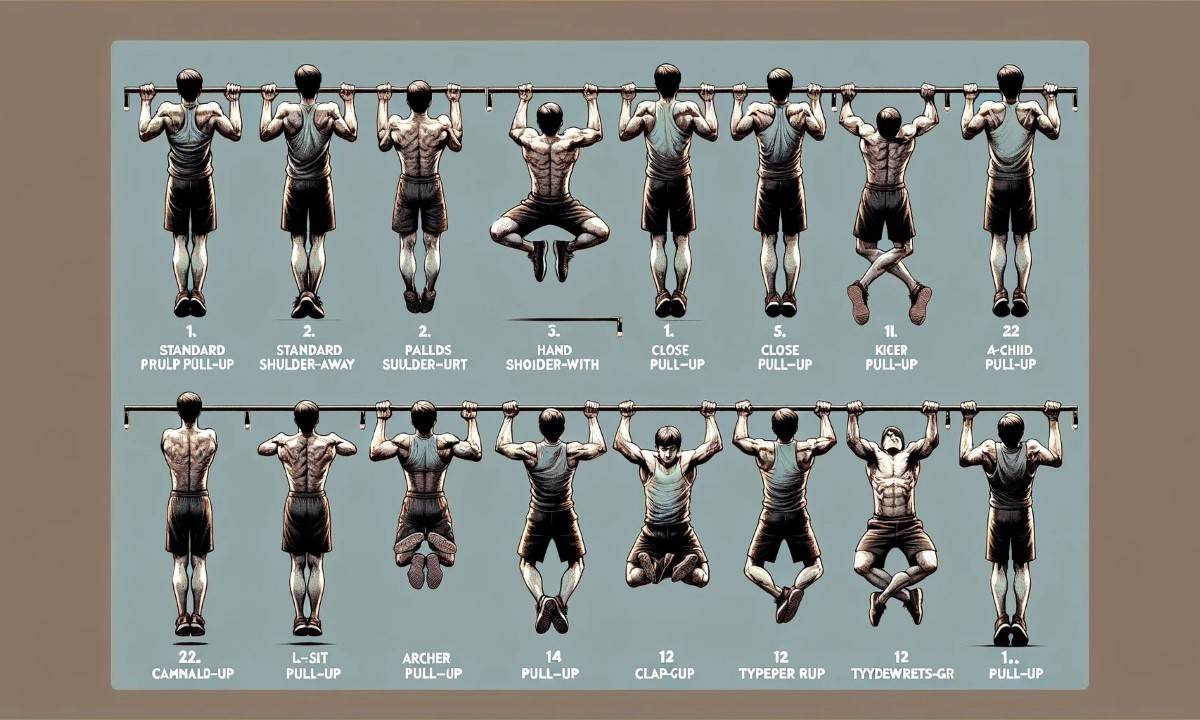Explore the world of Different Types of Pull Ups, from beginner-friendly techniques to pro-level variations. Elevate your upper body strength!
Introduction to Different Types of Pull Ups
Hello fitness enthusiast! Pull-ups, often deemed the king of upper-body exercises, are not just about showcasing one’s physical prowess but are pivotal in strengthening multiple muscle groups. The beauty of pull-ups is their adaptability, catering to both novices and pros. If you’re eager to dive deep into the world of pull-ups, we’ve got you covered! Let’s embark on this enlightening journey together.
The Basics: What is a Pull Up?

Ah, the classic pull-up! You’ve seen folks at the gym effortlessly hoisting themselves up a bar and thought, “How on earth…?”. Well, a pull-up is a compound exercise where you use your arms to pull your body upward until your chin is above the bar. Sounds simple, right? But there’s more to it.
Benefits:
- Upper Body Strength: One of the top exercises for targeting the muscles in your back, shoulders, and arms.
- Engages Multiple Muscles: While the primary muscles targeted are the latissimus dorsi (or lats), several stabilizer muscles like the biceps, triceps, and even the core get a piece of the action.
- Improves Grip Strength: If you’ve ever wanted to boast of a firm handshake, pull-ups are your ticket!
Fact: Did you know that the world record for the most pull-ups in 24 hours is a staggering 7,600? Talk about dedication!
Preparing for Your First Pull-Up
Before attempting your first pull-up, it’s crucial to be well-prepared. Setting a firm foundation will not only prevent injuries but will also pave the way for mastering more advanced variations in the future.
Equipment Needed:
- Pull Up Bar: A sturdy bar, either wall-mounted or a doorway pull-up bar.
- Gym Gloves (optional): To prevent blisters and ensure a firm grip.
- Resistance Bands: For those who need a little assistance to get started.
Warm-up Exercises:
- Arm circles
- Shoulder shrugs
- Dynamic stretches
Quote: “The best preparation for tomorrow is doing your best today.” – H. Jackson Brown Jr.
Different Types of Pull Ups
As you embark on this journey, remember that everyone starts somewhere. Here are a few Different Types of Pull Ups beginner-friendly variations to get you off the ground (literally!).
Australian Pull-Ups (Inverted Row)

A fantastic starting point. The Australian pull-up involves pulling yourself up to a bar set at waist height.
Steps:
- Stand facing the bar.
- Grip the bar slightly wider than shoulder-width, palms facing down.
- Lean back with arms fully extended, feet flat on the ground.
- Pull your chest towards the bar, squeezing your shoulder blades together.
- Lower with control.
Assisted Pull Ups
Need a little boost? No worries! Resistance bands or a trusty gym buddy can be your allies here.
Steps:
- Loop a resistance band around the pull-up bar.
- Place one foot (or knee) inside the loop.
- Grip the bar and perform a pull-up, using the band for assistance.
Negative Pull Ups
It’s all about the descent! Negative pull-ups focus on the downward motion, building strength for traditional pull-ups.
Steps:
- Stand on a bench or platform, gripping the pull-up bar.
- Jump up, getting your chin above the bar.
- Slowly lower yourself down.
Fact: Negative reps can cause more muscle soreness than traditional reps. But, no pain, no gain, right?
Stepping up your pull-up game? Let’s explore some challenging variations for those who’ve conquered the basics and are hungry for more.
Wide Grip Pull Ups

A tweak in grip, a leap in difficulty. This variation emphasizes the upper lats and broadens the back.
Steps:
- Grip the bar wider than shoulder-width, palms facing forward.
- Engage your core and pull yourself up, aiming to get your chin above the bar.
- Lower down with control and repeat.
Archer Pull Ups
Like an archer drawing a bow, this pull-up tests your unilateral strength.
Steps:
- Start with a wide grip.
- As you pull up, shift your weight to one side, extending the opposite arm straight.
- Return to center and repeat on the other side.
One Arm Pull Ups

The ultimate show of strength, the one-arm pull-up is the Holy Grail for many.
Steps:
- Grip the bar with one hand, placing the other on your wrist for stability.
- Engage your core and late muscles.
- Pull yourself up using just one arm, getting your chin above the bar.
Quote: “Strength does not come from physical capacity. It comes from an indomitable will.” – Mahatma Gandhi.
Read more about: Pull Workout Exercises: Sculpt Your Back in 30 Minutes
Common Mistakes and How to Avoid Them
While pull-ups can be super rewarding, it’s easy to fall into habits. Here’s what to watch out for about Different Types of Pull Ups:
- Using Momentum: Avoid swinging or using momentum. Focus on controlled movements.
- Incomplete Range of Motion: Always aim for full extension and contraction to get the most out of each rep.
- Not Engaging the Core: A strong core stabilizes your movements. Don’t neglect it!
Table:
| Common Mistake | How to Correct? |
| Swinging or Kipping | Use controlled, steady movements. |
| Elbows flaring out | Keep your elbows closer to your body. |
| Not going all the way up/down | Aim for the full range of motion. |
Incorporating Pull Ups into Your Routine
To truly master the art of pull-ups, consistent practice is key. Here’s how you can seamlessly incorporate them into your workouts:
- Frequency: Aim for 2-3 times a week.
- Repetitions: Start with what you can manage, gradually increasing as you build strength.
- Mix It Up: Rotate between different variations to challenge different muscle groups.
- Recovery: Remember to give your muscles time to rest and recover.
Fact: Pull-ups not only sculpt your upper body but also burn more calories than traditional cardio exercises.
In Conclusion, Different Types of Pull Ups
From humble beginnings of assisted pull-ups to the awe-inspiring one-arm variations, the journey of mastering different types of pull-ups is both challenging and rewarding. Whether you’re a newbie or a seasoned pro, there’s always a new height to reach, a new challenge to conquer. So, grip that bar, engage those muscles, and pull yourself up to greatness!
FAQs about Different Types of Pull Ups
Q1: Are there different types of pull-ups?
A: Yes, various types of pull-ups target different muscle groups and provide diverse challenges. Some common types include wide-grip, close-grip, chin-ups, and neutral-grip pull-ups. Each variation focuses on distinct areas of your upper body, allowing you to customize your workout routine.
Q2: What type of pull-up is best?
A: The best type of pull-up depends on your fitness goals. Wide-grip pull-ups are excellent for building broad shoulders, while close-grip pull-ups emphasize the biceps and the middle back. Chin-ups concentrate on the biceps, and neutral-grip pull-ups are easier on the wrists. Choose the one that aligns with your specific goals and comfort level.
Q3: What do different types of pull-ups work?
A: Different types of pull-ups work for various muscle groups. Wide-grip pull-ups target the lats and shoulders. Close-grip pull-ups focus on the biceps and the middle back. Chin-ups are great for biceps development. Neutral-grip pull-ups engage the brachialis and brachioradialis muscles. Incorporating a mix of these variations can provide a well-rounded upper-body workout.
Q4: Which pull-ups are the hardest?
A: The difficulty of pull-ups varies from person to person, but wide-grip pull-ups and one-arm pull-ups are considered the most challenging. These exercises demand significant upper-body strength and control. If you’re just starting, begin with the basic pull-up variations and gradually progress to more difficult ones as you build strength.



